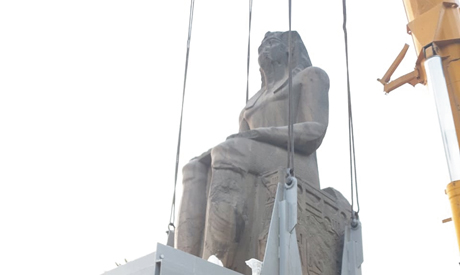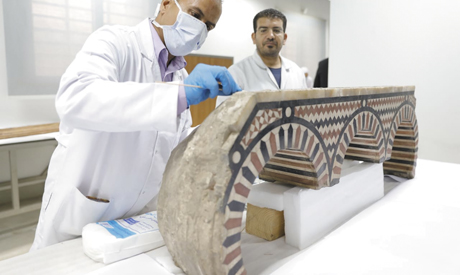http://english.ahram.org.eg/NewsContent/9/44/351519/Heritage/Museums/More-objects-at-new-museums.aspx
More objects at new museums
The unpacking of Sennedjem's coffin at the NMEC and the arrival of gigantic objects at the GEM were top heritage events in Egypt this week, reports Nevine El-Aref


The local and international media flocked to the museum to catch a glimpse of the opening of the container, and after a few minutes' work the cover was removed, revealing a beautifully painted anthropoid coffin depicting the features of Sennedjem and decorated with protection scenes from the Book of the Dead.

Removing the lid, another smaller coffin appeared with the mummy lying inside it in the Osiride-form with his arms crossed. The mummy was put on a stretcher and transferred to a neighbouring lab, where it entered a fumigation tent to stay there for almost 20 days before its actual restoration.

"It is like sophisticated surgery, to restore and preserve a mummy under the direction of skilled restorers," said Khaled El-Enany, the minister of antiquities, while witnessing the unpacking and fumigation process.
"The fumigation will rid the mummy of any insects or fungus that have affected it," said Mustafa Ismail, supervisor of restoration at the NMEC. It will then begin another process of restoration.

The outer coffin shows Sennedjem wrapped in bandages and holding the Knot of Isis in his left hand and the Djed Pillar, the emblem of Osiris, in his right hand. The body is decorated with hieroglyphic texts painted in intersected rows, between two of which a funerary scene showing the deceased with deities of protection appears.
He is shown wearing a wig embellished with a frieze of leaves and fruit and a necklace around his neck decorated with multiple threads and lotus flowers decorating its ends.
The coffin and one of his spouse were transferred to the NMEC from the Egyptian Museum in Cairo, and they were originally found among other grave goods in the intact tomb of Sennedjem in Deir Al-Medina on Luxor's West Bank, the settlement of the builders and craftsmen that undertook the construction work on the royal tombs in the Valley of the Kings.

In 1886, French Egyptologist Gaston Mapero discovered the tomb, which was a collective one because it was used as the burial place for at least three generations of the Sennedjem family. The burial chamber contained 20 mummies, nine of them in coffins belonging to the deceased, his wife, children and wives, while the others belonged to members of his family who might not have been rich enough to have their own carved coffins, along with a rich cachette and funerary collection.
During his life, Sennedjem served as "the Servant in the Place of Truth", during the reign of kings Seti I and Ramses II. He worked on the decoration of the nearby royal tombs and was allowed to create and decorate his own in the vicinity of those of his masters.
The tomb was found above the workmen's village at Deir Al-Medina and has a rectangular-shaped courtyard with three limestone pyramidal chapels. A wall originally divided the courtyard in two, separating the chapels of Sennedjem and his son from a second part containing the chapel of his father-in-law.
Like in many of the tombs in Deir Al-Medina, the paintings in the tomb are simply executed but are also remarkable for their colours and interesting scenes depicting the deceased with his wife in several postures before deities, during mummification, and in the expected afterlife.
In the Egyptian Museum both coffins were on display on the second floor along with a collection of Sennedjem's funerary objects such as ushabti figurines and boxes, pots, chairs, cosmetic chests, canopic jars, and a distinguished painting showing the deceased sitting beside his wife with a chapter from the Book of the Dead on one side.
AT THE GEM: In the vast, shade-dappled atrium of the Grand Egyptian Museum (GEM), the scene was totally different from at the NMEC this week, with the roar of heavy machinery filling the air and construction work surrounding the colossal statue of Ramses II and the column of his son Meneptah.
Beside them, on the footsteps of the GEM's grand staircase, stand four gigantic artefacts recently arrived from the Egyptian Museum where they were displayed in the garden. They include two rosy granite colossi of Senosert I, a 20-ton red granite triad statue featuring Ramses II between the deities Ptah and Sekhmet, and the top of a Hatshepsut obelisk weighing 14 tons.
Eissa Zidan, director of restoration and transportation at the GEM, explained that before the transportation the objects had been documented and restored. The collection had been placed inside iron cages and covered with special foam layers to absorb the vibrations caused during the transportation, he added.
"The trip lasted four hours, as the maximum speed of the vehicles was 7km per hour," Zidan said. The objects will now be restored before being placed in their final locations in the GEM.
Elsewhere in the GEM in the lab for wooden objects, the outer gilded coffin of king Tutankhamun was removed from its fumigation tent this week and the conservation work begun.
The coffin was transferred to the GEM in July for restoration for the first time after 97 years lying inside the quartzite sarcophagus inside the king's tomb in Luxor. It was placed inside a plastic incubator with state-of-the-art equipment to fumigate it as a first step in its restoration. After six weeks, the restoration work has started.
"The coffin is finally being restored for the first time since its discovery inside the tomb in November 1922," El-Enany said, adding that soon after the discovery of the tomb the innermost gold coffin and the middle gilded wooden coffin were transferred to the Egyptian Museum in Cairo, while the large outer gilded coffin was left inside the tomb with the king's outermost quartzite sarcophagus.
The outer coffin had now been transferred to the GEM for restoration in order to be exhibited on the museum's opening in 2020, together with the boy-king's treasured collection and the two other coffins.
"The golden Pharaoh's three coffins will be displayed together for the first time since their discovery, and as Tutankhamun wished them to be," El-Enany said. He explained that the coffin had been in poor condition as it had never been restored and had been left inside the tomb where it had been subject to humidity, heat and erosion.
"It is the only royal coffin in the Valley of the Kings carved in the organic material of wood, since all the others are sarcophagi carved in stone," El-Enany said.
Al-Tayeb Abbas, supervisor for archaeological affairs, told Al-Ahram Weekly that preliminary examination carried out on the coffin before transportation had revealed that it had developed cracks in its gilded layers of plaster, especially those on the lid and base.
Atef Moftah, supervisor of the GEM project and its surrounding area, told the Weekly that the construction work on the GEM would be completed at the end of this year and the newly transported obelisk from the San Al-Hagar archaeological site in Zagazig in the Delta would also join the collection of the GEM.
He said it would be put on show in the Obelisk Square at the GEM's main entrance and would be the first obelisk in the world to be placed in a special display, offering visitors the opportunity to walk beneath it and see the cartouche of Ramses II engraved on its bottom. Ancient Egyptian royal figures used to engrave their cartouches on the bottoms of obelisks as a mark of ownership.
The estimated cost of the GEM project is $1.6 billion, with costs increasing as a result of delays but still being trimmed by some $770 million. Some 44 of the 87 large objects that will be exhibited on the GEM's grand staircase have already been transported. Moftah told the Weekly that the GEM had a 17-metre esplanade in front of it and a striking architectural design that incorporated a wall 50 metres high and 800 metres long with a total surface of 27,000 square metres.
The GEM complex, overlooking the Giza Plateau, is a cultural institution located on an area of approximately 500,000 m2. Adjacent to the Pyramids of Giza, the complex includes one of the largest museums in the world, displaying the heritage of the ancient Egyptian civilisation. It will contain over 100,000 artefacts, reflecting Egypt's past from prehistory through the Greek and Roman periods and is set to open in 2020.
-- Sent from my Linux system.
No comments:
Post a Comment